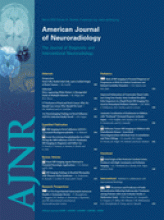CT perfusion (CTP) provides the unique ability to noninvasively quantify the microvascular blood flow of tissue. Most neuroradiologic applications have been focused on brain perfusion with specific emphasis on stroke, vasospasm, and cerebrovascular reserve. There have also been several oncologic investigations suggesting that CTP parameters of blood flow (BF), blood volume (BV), mean transit time, and capillary permeability (CP) may be beneficial in assessing both intracranial and extracranial neoplasms.1–5 Early reports have suggested that head and neck squamous cell carcinoma (HNSCC) with elevated BV has a greater likelihood of complete response when treated with nonsurgical organ-preservation therapy (NSOPT).4 Other studies have suggested that serial reductions in BV and BF provide an objective and quantitative method of identifying tumors that have initially responded to neoadjuvant chemotherapy.
In the March issue of the American Journal of Neuroradiology, Šurlan Popovič et al6 and Bisdas et al7 present 2 important investigations, which substantially add to our understanding of the ability of CTP to predict “up-front” response to NSOPT and play a possible role in treatment monitoring. In the first article, Šurlan Popovič et al suggested that certain pretreatment CTP parameters (BF and CP) are predictive of local control with NSOPT and introduced the concept of BV/BV mismatch for helping predict response. In the second article, Bisdas et al demonstrated that serial reductions in BV during treatment were predictive of response, whereas progressive elevations in BV were identified in nonresponders and are consistent with previously published reports.
The next obvious question is “so what?” or “why should we care?” To answer these questions, we must first understand how treatment regimens for HNSCC and other malignancies are determined. The preferred treatment options for most malignancies are based on population estimates that have resulted in the best local control and cure rates for the population as a whole. A patient can then attempt to assess his or her own probability of cure from the various treatment choices on the basis of these population estimates. Thus, the individual treatment regimens are essentially “fixed” regimens, and one can argue that the patient is the “variable,” often leading to the saying “the patient failed therapy” as opposed to “the treatment failed the patient.”
We have learned the hard way that the best chance to cure cancer is to eradicate the tumor on the initial treatment attempt. The likelihood of long-term cure in a recurrent tumor or one that never completely responded is poor, with reported salvage rates for HNSCC not exceeding 20%. In the past, the preferred treatment regimens have been based on the initial Tumor, Node, Metastases (International Union Against Cancer) staging. These are anatomic assessments of the tumor size and spread. More recent developments have resulted in more biologically targeted therapy, with newer chemotherapy agents targeted to specific proteins overexpressed by certain tumors (bevacizumab, vascular endothelial growth factor; cetuximab, epidermal growth factor).
These advances herald the age of individualized therapy, with specific treatment regimens designed to treat the unique biologic characteristics of each tumor. The next, and some would argue the most important step, is to attempt to determine the response of a tumor during treatment as opposed to the “wait and see” approach. Biologic imaging information, such as that obtained with CT/perfusion MR imaging or MR imaging diffusion techniques, which can predict if a tumor is less likely to respond to a certain NSOPT treatment regimen, would warrant an alternative treatment such as surgery. Similarly, biologic information suggesting that a tumor is not responding to NSOPT during treatment would warrant treatment modification, such as dose escalation and adjuvant chemotherapy or surgical resection. For residual or recurrent disease, salvage surgery may be available as a curative treatment for only a limited number of patients. However, complication rates of salvage surgery after radiation therapy (RT) are high, with wound-healing problems as a well-known complication in patients treated with radiation. Moreover, the locoregional recurrence rate after salvage surgery (without the option of postoperative irradiation) is high. Therefore early identification of nonresponders to RT would avoid the morbidity and cost of a futile extensive RT and possible complications of salvage surgery after RT in a substantial number of patients. In those patients, survival may improve if RT is abandoned and salvage surgery is performed, including the possibility of postoperative radiation. This tailored approach has the potential for increasing local control and overall survival with fewer complications.
The results of the CTP initial investigations are promising and suggest that CTP has the ability to predict response to NSOPT. A recent investigation indicated that BF and BV were directly correlated with microvascular density (MVD), confirming that CTP can be used as a noninvasive surrogate marker for measuring MVD and potentially tissue hypoxia. The next step is to validate these findings and attempt to correlate the biologic imaging and histologic changes. In recent similar studies exploring the predictive value of diffusion in patients with HNSCC, Kim et al8 and Galbán et al9 showed that diffusion MR imaging may also have predictive value both pretreatment and shortly after the start of therapy for the results of chemoradiation. The ability to accurately determine the response of a tumor during any NSOPT and to modulate the dose at this time, as opposed to our current “watch and wait” approach, should be the hallmark of individualized therapy. Šurlan Popovič et al6 and Bisdas et al7 have made very important scientific contributions, which take us 1 step closer to the “Holy Grail” of cancer treatment.
References
- Copyright © American Society of Neuroradiology












